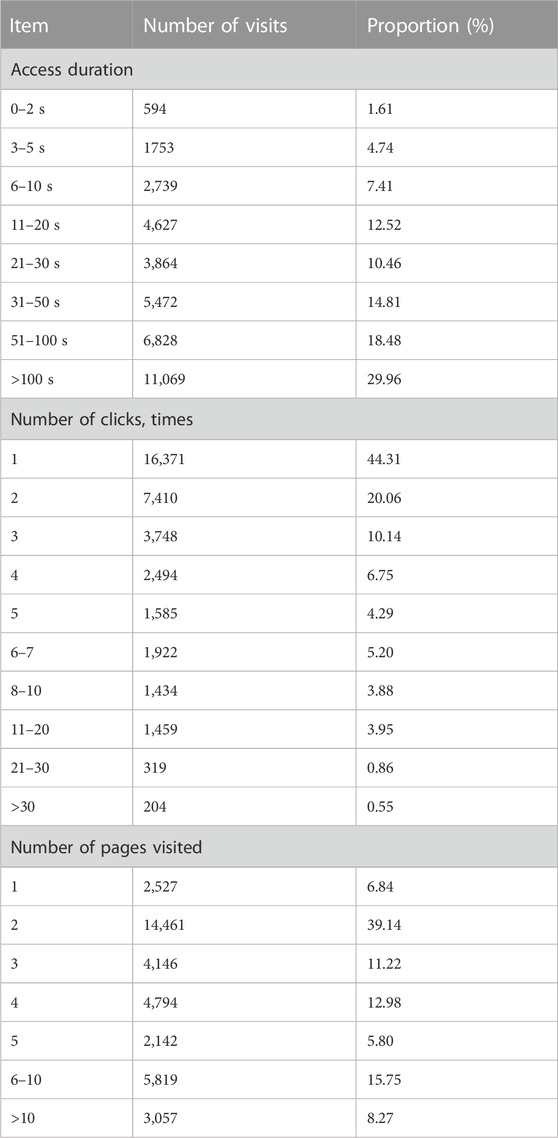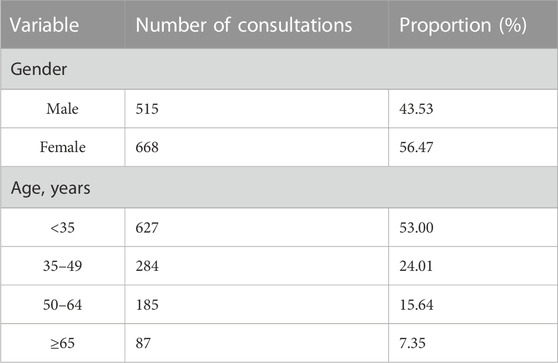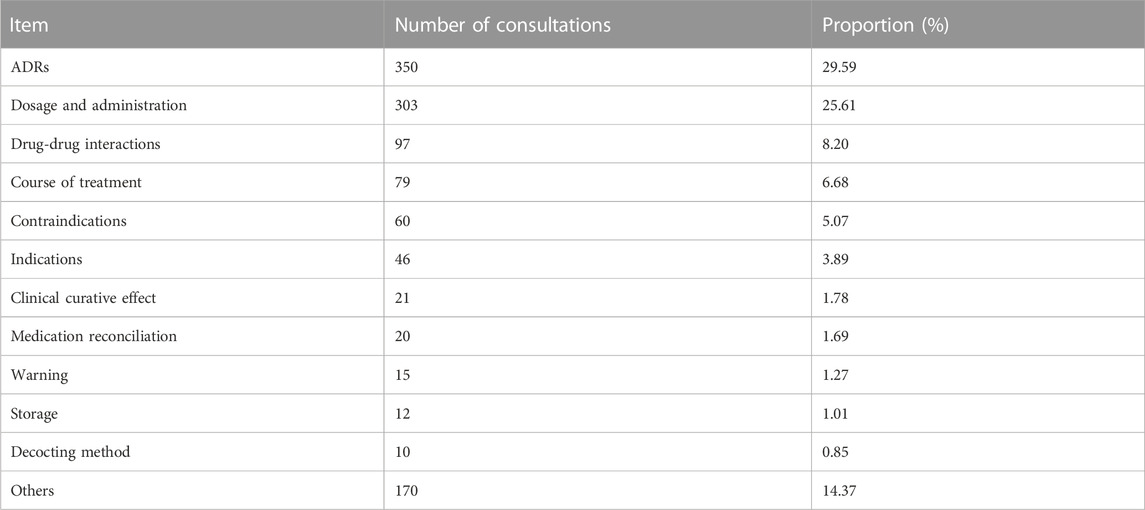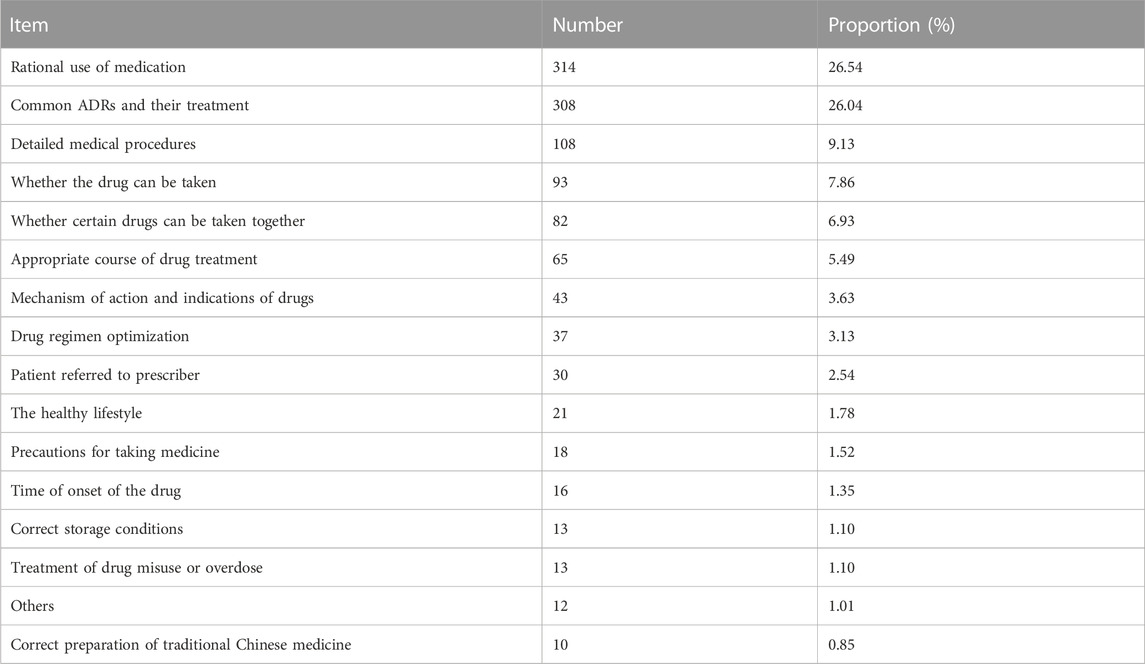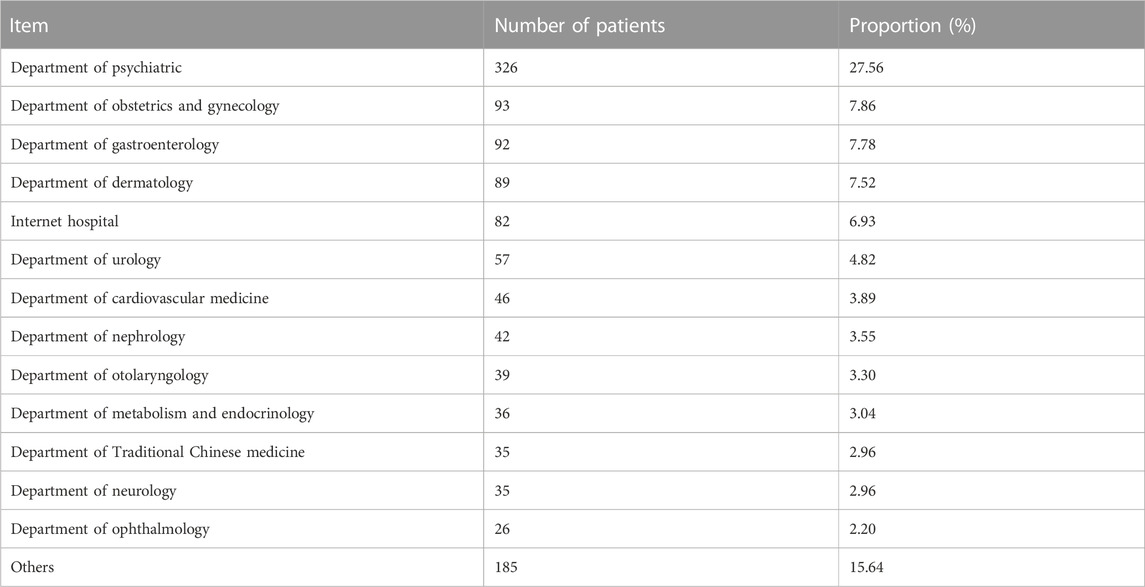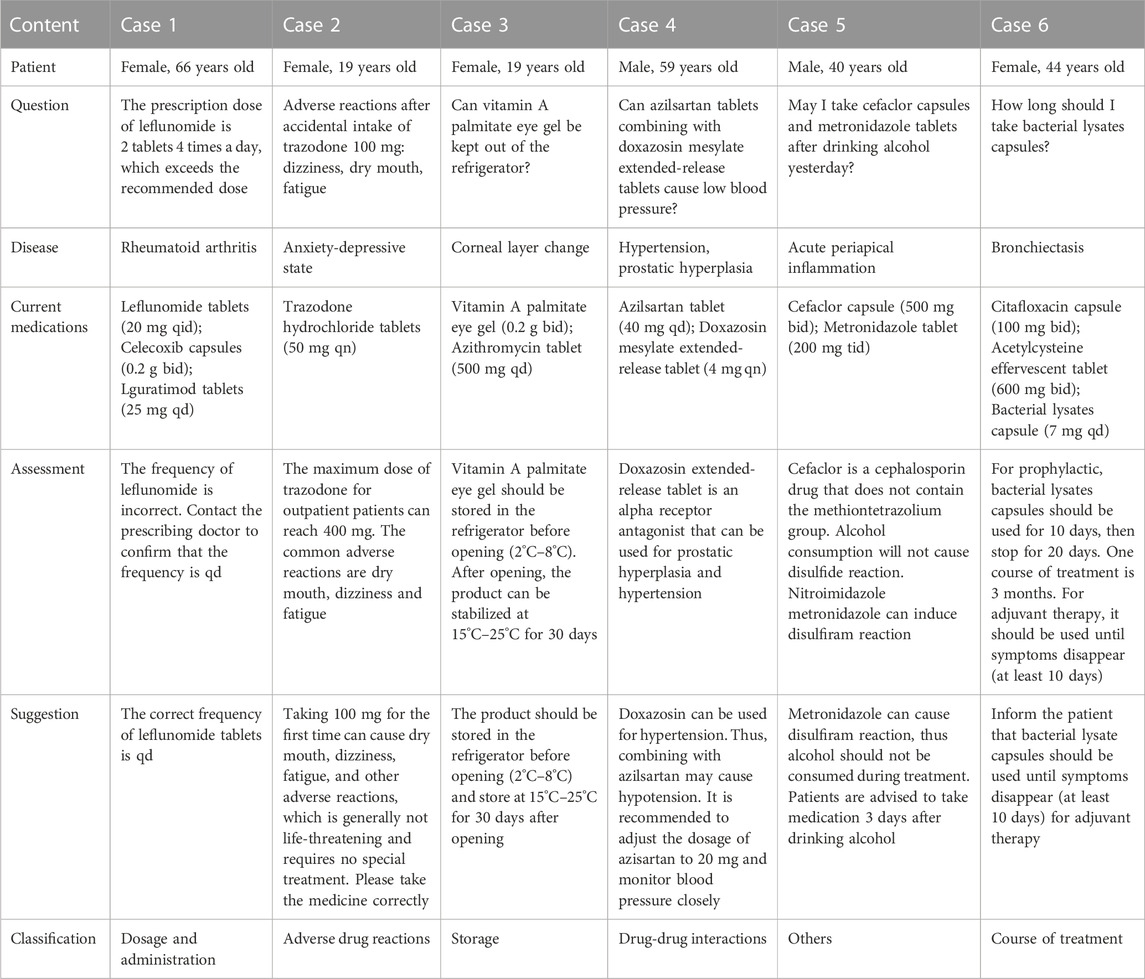- 1Department of Pharmacy, The Second Xiangya Hospital, Central South University, Changsha, China
- 2Institute of Clinical Pharmacy, Central South University, Changsha, China
Background: Time and space constraints have often hindered the provision of optimal pharmaceutical care, limiting medication therapy management. Social media tools have gained significant popularity in the field of pharmaceutical care. This study aimed to develop a WeChat-based intelligent medication manager platform that facilitates online pharmaceutical care and encourages self-management.
Methods: We developed a WeChat-based Internet pharmacy service platform called Xiang Medicine Guidance (XMG). Through the analysis of surveys and user access data, we evaluated the demand and utilization of the XMG platform and assessed patients’ satisfaction with its services. Patients’ adherence before and after the XMG platform intervention was also investigated.
Results: The XMG platform was launched in November 2022, offering medication guidance, reminders, and consultation services through the WeChat mini-program. By the end of April 2023, the platform had attracted 141.2 thousand users, accumulating 571.0 thousand visits. Moreover, 1,183 clients sought online medication consultations during this period. Six months after the launch of XMG, an impressive 91.02% of users expressed their satisfaction with the platform. The medication reminders and consultations provided by XMG significantly contributed to medication adherence, with 56.02% of users categorized as having good adherence, better than the previous 47.26%.
Conclusion: Through its services and features, XMG empowers patients to better manage their medications, seek professional advice, and adhere to their prescribed treatment plans. XMG has the potential to positively impact public health on a broader scale.
1 Introduction
The therapeutic efficacy of medications is closely related to patients’ adherence to drugs and the ability to self-manage their treatment. However, in China, there is a significant disparity between the number of licensed pharmacists and the population, leading to challenges in patient care. In February 2023, the China Food and Drug Administration reported only 716,207 registered pharmacists (5.1 per 10,000 people). This figure falls short of the global standard of 6.2 pharmacists per 10,000 population observed in developed countries (Feng et al., 2022). Furthermore, the distribution of pharmacy resources throughout China is uneven, with most pharmacists concentrated in teaching hospitals or urban areas. This leaves remote and impoverished regions with limited access to pharmacy services (Feng et al., 2022). The scarcity of pharmacists contributes to inefficiencies in the healthcare system. Pharmacists are burdened with repetitive dispensing tasks, which detracts from their valuable time. The time and space constraints associated with pharmaceutical care hinder the effective management of medication therapy, leading to various long-term medication-related issues (Zhang et al., 2020). For example, many patients do not know how to administer medications correctly. Some patients take drugs without fully understanding their potential adverse drug reactions (ADRs). After leaving the hospital, patients often lack avenues to consult a doctor or pharmacist for guidance. Recognizing these challenges, healthcare administrators have called hospitals to prioritize information infrastructure development, strengthen patient follow-up, and provide comprehensive medication guidance services.
Effective communication and trust between professionals are crucial to improving patient health outcomes (Zheng et al., 2022). Fortunately, the rapid advancement of information technology has expanded the scope of pharmaceutical services beyond traditional pharmacy dispensing processes and clinics (Yap et al., 2009; Xiao et al., 2013). Informatics and the internet have gained significant popularity in the modern pharmaceutical care system, offering a partial solution to the problem of insufficient pharmacists in remote areas (Wang et al., 2022). Various tools and platforms, including multimedia resources, self-service inquiry machines, and WeChat platforms, have been recommended to provide patients with valuable information on drug usage, dosage, and precautions.
Social media-based tools are increasingly tailored to specific needs to overcome the challenges posed by limited location-based resources and improve the speed of information sharing in healthcare systems (Redfern et al., 2013; Patel et al., 2015; Jalil et al., 2019; Wang et al., 2021). Recognizing the potential of these tools, the China Food and Drug Administration has emphasized the role of pharmacists in physical medical institutions in providing pharmaceutical care on the Internet. These pharmacists are tasked with offering online medication guidance, medication consultations, and other related services, focusing on patients with chronic conditions such as hypertension and diabetes. In China, pharmacists are exploring mobile health approaches using existing popular APPs to promote the rational use of medications among patients (Chen et al., 2020; Hua et al., 2020; Sun et al., 2020).
In China, WeChat is the dominant social media application, boasting an international monthly active user base of more than 1.268 billion in 2021 (Tso, 2022). Globally, WeChat is among the most popular social networks, along with WhatsApp, Facebook, YouTube, and Instagram (Li et al., 2019a). Although WeChat’s user base and influence continue to grow, its application and adoption among healthcare professionals have received relatively less attention. In recent years, particularly with the spread of COVID-19, WeChat has been used in various healthcare settings to improve patient care in China (Hua et al., 2020; Li et al., 2021; Liang et al., 2022). Physicians, nurses, and pharmacists have embraced the innovative application of WeChat to enhance patient comprehension of treatment and improve follow-up management. Notable examples include the implementation of a self-management intervention through WeChat, as demonstrated in a randomized controlled trial conducted in Guangzhou province (Li et al., 2019b). The trial showed that a 6-month health education intervention, health promotion, group chat, and blood pressure monitoring via WeChat helped patients lower their blood pressure and improve self-management effectiveness. Another study in Shandong province confirmed the positive impact of a WeChat-based pharmaceutical care program in post-discharge patients with non-insulin-dependent diabetes mellitus and hypertension. This program markedly improved medication adherence among participants (Wang et al., 2022). As a leading Internet messaging tool, the multifunctional WeChat official account and WeChat groups have effectively served as a communication bridge between patients and medical staff, leading to successful implementation in disease-specific pharmaceutical care. However, the current approach of increasing communication within a limited number of patient groups is no longer sufficient to meet the growing patient demand.
The medical landscape has witnessed the proliferation of more than 318,000 medical apps designed to aid in disease diagnosis and management (Huang et al., 2022). One such notable example is the novel shared WeChat app developed by Huang et al., specifically tailored to address dental anxiety. This app has demonstrated its effectiveness in providing support before and after dental procedures, and in assisting the management of high-risk patients during the COVID-19 pandemic. Beyond dental anxiety, private healthcare support companies have used WeChat capabilities to improve the monitoring and collection of personal health data (Zhang et al., 2017; Tso, 2022). Despite these advances, there remains an urgent need to develop a comprehensive pharmaceutical care app that caters to the needs of all outpatients.
To promote high-quality pharmaceutical care and advance the construction of a healthy China, the Second Xiangya Hospital of Central South University in Changsha, China, has established a WeChat-supported platform called Xiang Medicine Guidance (XMG). This platform allows patients to access comprehensive medication guidance, medication reminders, and online pharmaceutical consultation services. This study aimed to create a WeChat-based intelligent medication manager platform that facilitates pharmaceutical care and promotes self-management. The impact of this platform was assessed through patient surveys and analysis of platform access.
2 Materials and methods
2.1 Study design
This study consisted of two surveys. The initial survey was conducted before the launch of XMG to gather data on patients’ perceptions of medication guidance. The survey aimed to assess the perceived necessity of medication guidance, how patients currently receive medication guidance, the specific content of medication guidance they desired, and patients’ medication adherence. The questionnaire survey form is shown in Supplementary Table S1. The information obtained from this survey played a crucial role in the design and development of XMG. The survey participants were randomly selected from patients visiting outpatient clinical departments at the Second Xiangya Hospital of Central South University between January and March 2022. In April 2023, 6 months after the launch of XMG, a second survey was conducted among users of the XMG platform to evaluate the impact of XMG, including user satisfaction with the platform and its influence on medication adherence. These users included individuals who independently accessed XMG or accessed it with the help of their relatives on smartphones. The survey specifically targeted XMG users who visited outpatient clinical departments. The questionnaire survey form is listed in Supplementary Table S2.
The sample size (n) was calculated using the following formula to estimate the proportion of a single population: n = (Zα/2)2p (1-p)/d2. With a 95% confidence interval and a 5% marginal error, the minimum sample size required was determined as follows: n = (1.96)2 * (0.5) * (0.5)/(0.05)2 = 384. Since no published studies were comparable to this study, a proportion value (p) of 0.5 was used in the calculation. A sample size greater than 384 was considered scientific and feasible. To account for the expected non-response rate, 10% was added to the minimum sample size, and the final sample size was 422.
The following question was asked to assess medication adherence: “Do you experience instances of missed doses or non-adherence with medication instructions?” The response options were as follows: Frequently, Occasionally, Rarely, and Never. If the response was frequent or occasionally, it was categorized as poor adherence. Otherwise, if the response was rare or never, it was classified as good adherence.
The inclusion criteria for both surveys required participants to be able to speak and write Mandarin Chinese. Patients who did not wish to participate were excluded. The questionnaires were administered and completed on-site. The questionnaires collected demographic and socioeconomic data, including information on sex, age, marital status, educational background, place of residence, and number of medical visits.
In addition to the questionnaire survey, the impact of the XMG platform was evaluated by analyzing user access data. Various metrics were considered, including the duration of access, the number of clicks made, the number of pages visited, the types of medication consultations sought, and the outpatient clinical departments visited by patients.
2.2 The development of the WeChat-based intelligent medication manager
XMG is a smartphone WeChat APP that has been collaboratively designed and developed by Beijing Zuoyi Technology Co., LTD. and the Department of Pharmacy at the Second Xiangya Hospital of Central South University. XMG was officially launched in November 2022. This integration was embedded in the WeChat network platform, enabling comprehensive pharmaceutical care services. The underlying intelligent algorithm technology encompassed various components, such as large-scale text mining, structured data-based knowledge graph construction, intelligent interaction, and an intelligent disease diagnosis system. The knowledge base incorporated many authoritative sources, including the China Pharmacopeia, drug instructions, clinical treatment guidelines, and reputable medical books. The algorithm learning process involved analyzing a substantial amount of medical papers, popular science articles, and the expertise of physicians and pharmacists. Furthermore, recognizing the importance of customized interaction, a suitable intelligent interactive network system was developed for pharmacists and patients, considering the hospital’s unique circumstances.
2.3 The content of the WeChat-based intelligent medication manager
The hospital’s outpatient pharmaceutical care system is integrated into a cloud database named XMG (Figure 1), which provides patients with convenient access to medication guidance, medication reminders, and medication consultation through a WeChat mini program, eliminating the need to download additional applications. Figure 2 shows the XMG pharmacy service framework. Once a drug is prescribed, patients receive an automated medication guidance report from the hospital’s official WeChat account. Clicking the message link allows patients to access the medication guidance report, review medication reminders, and interact online with senior pharmacists. XMG has the following three interfaces.

FIGURE 1. The main interface of the Xiang Medicine Guidance provides convenient access to three essential sections. Medication Guidance, Medication Reminder, and Medication Consultation. Patients can easily find and use the Xiang Medicine Guidance mini program by simply scrolling down on the main screen of WeChat, without the need to download additional applications.
2.3.1 Medication guidance interface
After prescribing medications, patients will receive a drug guide report through their WeChat accounts (Figure 3). This comprehensive report includes essential information such as dosage and administration instructions, precautions, warnings, potential ADRs, contraindications, and popular science education services like disease rehabilitation guidance and healthy lifestyle recommendations. To accommodate individual needs and preferences, personalized settings are encouraged within XMG. For patients with visual impairments or limited literacy, XMG offers a voice function that allows medication instructions to be spoken for ease of comprehension. Additionally, XMG supports automatic font enlargement for older patients to enhance readability. Furthermore, XMG converts the units of measurement on the prescription into easily understandable packaging units, such as “one tablet” or “one capsule.”
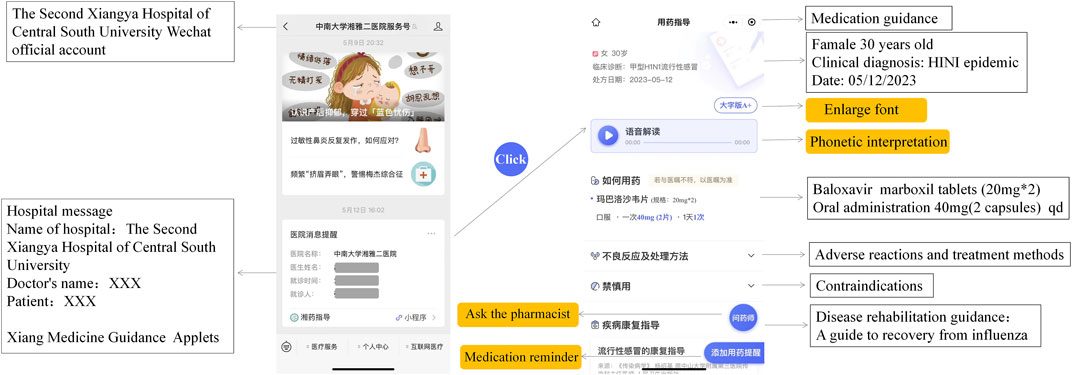
FIGURE 3. Medication guidance interface. After prescribing, a drug guidance report will be sent to patients’ WeChat, through which, patients can enter the interface of medication reminder and medication consultation interface.
2.3.2 Medication reminder interface
XMG incorporates intelligent computing to determine the optimal time for patients to take each medication, considering factors such as drug absorption, patient daily habits, and potential medication interactions (Figure 4). When it is time for patients to take their medications, XMG provides a reminder alarm or notification. For drugs with a limited course of treatment, XMG reminds patients to discontinue the medication at the appropriate time. Similarly, for drugs with a limited shelf life after opening, such as eye drops, XMG notifies patients when the drug is no longer suitable for use. In XMG, if patients record the remaining doses of their medications in the “My Medicine Cabinet,” they will receive timely reminders when the quantity of the drug is running low. These reminders prompt patients to schedule a visit to the hospital for a refill or prescription renewal.

FIGURE 4. Medication reminder interface. Patients can add a medication plan and enjoy an alarm clock reminder service.
2.3.3 Medication consultation interface
XMG offers convenient online medication consultations to patients. At any time and from anywhere, patients can access the “Ask Pharmacist” feature within XMG to ask questions about their medications. They can communicate by texting or sharing pictures (Figure 5). Pharmacists are available to provide one-to-one online medication consultation services to patients. These consultations can be conducted through text or voice interactions depending on the pharmacists’ preference.
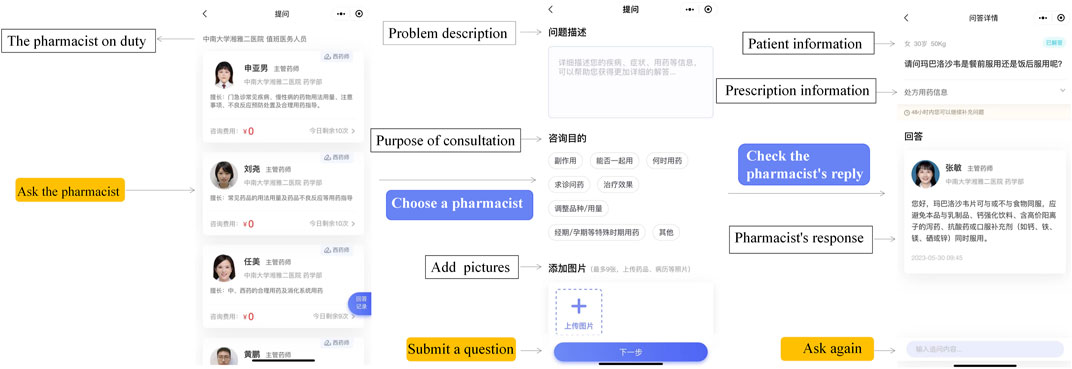
FIGURE 5. Medication consultation interface. When having medication questions, patients can consult the pharmacist on duty through text, pictures, and prescription.
Furthermore, pharmacists can use XMG to follow up with patients. The patients will be systematically screened through the hospital information system when the follow-up plan is formulated. The XMG platform will regularly send popular science education messages and medication follow-up questionnaires to specific patients. These inquiries may cover medication adherence, efficacy, and ADRs. Pharmacists or physicians can then evaluate the patient’s treatment progress and engage in real-time communication with the patient based on the collected information. For patients with poor medication adherence, unsatisfactory drug treatment effect, or severe ADRs, the pharmacist will contact them by telephone and guide them to use the drug rationally.
2.4 Data analysis
Data were analyzed using SPSS software (version 22.0, SPSS Inc., Chicago, United States). Categorical variables are expressed as numbers and percentages.
3 Results
3.1 Patient characteristics
In the first survey, 450 questionnaires were distributed, and 419 valid questionnaires were analyzed. The demographic and clinical characteristics of the patients are presented in Table 1. Most patients were under 35 years of age (51.07%) and had a bachelor’s degree as their highest level of education (57.56%). Most patients resided in urban areas (65.39%).
The need and patient requirements for pharmaceutical care are summarized in Supplementary Table S3. Although 98.33% of patients considered medication guidance necessary, only 17.42% consulted pharmacists when they had questions about their medications. Regarding the preferred content and format of medication guidance, 45.83% preferred Internet or telephone-based consultations. Furthermore, 78.28% wanted medication reminder services through a mini program. Among the various aspects of medication guidance, the dosage and administration of drugs were the most preferred (72.79%), followed by contraindications and precautions (65.63%) and indications (64.68%). As for medication adherence, only 47.26% of the users were considered to have good adherence.
3.2 User access data analysis
At the end of April 2023, XMG had attracted 141,200 users, with a remarkable 571,000 visits recorded over the 6 months. To examine the extent of patient engagement with the medication guidance report, we analyzed the length of visits, the number of clicks, and the number of pages accessed by clients in April 2023. The findings are presented in Table 2. The analysis revealed that 29.96% of the patients spent more than 100 s accessing the medication guidance report. Regarding the frequency of accessing the report, 44.31% of the patients opened it only once, while 20% accessed it twice. Regarding the number of pages visited within the report, 39.14% of the patients explored two pages.
Our medication consultation platform currently provides free pharmaceutical services for patients and the public to improve their awareness and satisfaction with pharmacists. Ten senior pharmacists were responsible for providing online medication consultation services. When a patient seeks consultation, the system automatically extracts relevant information such as the patient’s sex, age, doctor’s diagnosis, and prescription details. Pharmacists were expected to respond to patients within 12 h, and the completion rate for timely responses was 100%. Pharmacists answered 1,183 questions.
The data from these medication consultations were analyzed and summarized. Table 3 shows the demographic and clinical characteristics of patients seeking consultations. Among these consultations, 668 (56.47%) were from female patients. Most consultations (53.00%) were from patients under 35 years of age. Table 4 shows the content of the consultations, Table 5 displays the classification distribution of advice provided by pharmacists, and Table 6 shows the distribution of consultations across different departments. The five main categories of consultations requested by patients were ADRs (29.59%), dosage and administration (25.61%), drug-drug interactions (8.2%), treatment duration (6.68%), and contraindications (5.07%). Pharmacists informed the patients of the correct usage and dosage, common ADRs and their treatment, detailed medical procedures, whether to take drug and whether certain drugs can be taken together. Patients who visited the departments of psychiatry, obstetrics and gynecology, gastroenterology, dermatology, and the Internet hospital made the highest number of drug consultation inquiries. Table 7 provides several specific examples of consultations.
3.3 Patient satisfaction and medication adherence
In the second survey, 420 questionnaires were distributed, and 407 were considered valid and analyzed. Demographic data are shown in Supplementary Table S4, and patients’ satisfaction and medication adherence are exhibited in Supplementary Table S5. Users showed high satisfaction with XMG, with 91.40% (372 out of 419) expressing their satisfaction. In terms of medication adherence, 56.02% of the users were considered to have good adherence.
4 Discussion
Studies have reported that 50% of patients struggle to use medications properly (Brown et al., 2016). To address this problem, various strategies, such as adverse reaction monitoring, medication tracking, medication reminders, and recording of patient’s medication history, have been implemented to reduce medication errors. However, due to the shortage of professional pharmacists in China, providing high-quality pharmaceutical care has become a challenge. The traditional face-to-face pharmaceutical care model needs to be revised in response to this challenge. Consequently, many medical institutions and computer scientists use technology to offer patients more efficient and convenient healthcare services.
Several mobile health tools have been developed and researched to support patients in managing their medications. For example, a web-based pharmaceutical care plan application potentially facilitated the collaboration between healthcare providers and patients. In addition, Zhang et al. (2022) developed an anticoagulation management model for anticoagulation therapy in atrial fibrillation patients. This model aims to enhance rationality, adherence, and satisfaction for medical professionals and patients. Another example is the WeChat-supported platform called Medication Housekeeper, which promotes self-management of cancer patients experiencing pain by facilitating collaboration between physicians and pharmacists. This collaboration aims to optimize therapeutic outcomes (Zhang et al., 2021). However, most of these applications focus on managing drug therapy for specific medications or diseases, none provides comprehensive pharmaceutical care for outpatients with various medical conditions. We have designed and developed the XMG medication manager platform to provide outpatient medication guidance, reminders, and consultations.
The XMG has the following innovations. First, a localized deployment of servers where all patient prescription data is stored on a local server. Through a front-end device, we interact with a third-party company’s cloud-based knowledge repository and mobile applications, ensuring the privacy and security of patient data. This setup allows us to fully retain the rights to independently utilize research data and related intellectual property. Second, existing APPs provide medication guidance and consultation for specific groups (such as a particular disease or medication). However, XMG provides comprehensive online pharmaceutical services to all patients receiving treatment in our outpatient clinics and through Internet hospitals. Third, we proactively send medication guidance information to all outpatient patients via WeChat. The patient’s prescription data automatically accompany this information and can be used to enable medication reminders in one click. Patients with medication questions can easily access pharmacist consultations in one click. Fourth, patients who do not receive treatment at our hospital or individuals in the general public can also utilize the XMG mini-programs for online pharmaceutical consultations and medication reminders.
Implementing XMG can enhance pharmaceutical care in hospitals and improve the quality of medication management through information technology.
Numerous users have experienced the substantial impact of XMG in providing medication guidance and consultation, effectively supporting patients with their medication needs. The survey also indicates high user satisfaction with the pharmaceutical care provided by XMG. According to the report, multitudinous APPs only involved dozens or hundreds of patients for the comparative study; their number of users was not shown (Huang et al., 2022; Liu et al., 2022; Sun et al., 2022). The “Cloud Pharmacy Care” platform acquired 1,432 views and completed 39 counseling cases in 2 months, was much less than the XMG (Li et al., 2021). Despite the short establishment time, the patient’s attention and the number of consultations in XMG were very high. This may be mainly due to the significant number of outpatient clinics in our hospitals and the initiative of medication guidance information.
The availability of medication reminders and pharmacist consultations has played a crucial role in improving medication adherence. As a result, the proportion of users categorized as having good adherence increased from 47.26% to 56.02%. These results underscore the effectiveness of XMG in promoting medication adherence and enhancing patient outcomes. However, compared to other projects dedicated to improving the pharmaceutical management of a particular type of patient, XMG has a limited effect on patients’ medication adherence (Chen et al., 2020; Wang et al., 2022). It is closely related to the short establishment time and the lack of targeted patient medication management. In the next stage, the pharmacist would employ the medication follow-up function to conduct follow-up management for patients with specific diseases to improve their medication adherence. Through the evaluation of patient consultation records, several interesting findings have emerged. Women were more inclined to use XMG for medication counseling than their male counterparts, which was similar to that of other mini-program users (Li et al., 2021). Counseling was available for patients or the public of all ages. Despite efforts to simplify the mini program, online medication counseling still predominantly attracts patients under 35 years of age. This may be related to their willingness to accept new things.
The ADRs and the psychiatric department ranked first by analyzing the classification and department distribution. There may be several reasons for the difference between the literature (Gotlib et al., 2017; Patel et al., 2020). First of all, the reputation of our hospital’s psychiatric department is prominent in China, and many patients come here. Second, patients with psychiatric conditions are generally young and more able to use XMG. Most importantly, antipsychotic medications often cause ADRs, such as drowsiness, dizziness, hyperactivity, and sedation. This poses a significant obstacle to adherence to antipsychotic regimens. The responses and encouragement of pharmacists can play a crucial role in improving treatment outcomes for psychiatric patients. A significant challenge facing many patients is assessing, differentiating, and managing adverse drug reactions, particularly among psychiatric patients. In future work, we plan to follow patients with mental illness to improve their medication adherence and therapeutic effect. Consultations on using polyethylene glycol-containing electrolyte powder appropriately before colonoscopies and topical medications were common among patients. This highlights the importance of conducting in-depth medication education and counseling for these specific medications to ensure their proper use in the future.
In China, “Mobile Internet + pharmaceutical care” gradually changed medical practices and processes. XMG offered a solution to the problem of gaps in pharmaceutical management after patients left the hospital. Through XMG, patients can access and review the medication guidance report anytime, and healthcare professionals can efficiently monitor patient indicators and provide prompt suggestions. Furthermore, medication guidance collected from various hospitals can be consolidated into a comprehensive medication history, facilitating physicians’ understanding of a patient’s past medication experiences. The survey results demonstrate that XMG is a convenient, cost-effective, and reliable pharmacy application. Its benefits extend to outpatients and emergency cases, patients with chronic diseases, and people seeking daily pharmacy consultations.
This study has several limitations. First, the participants were recruited from a single tertiary hospital, which may restrict the generalizability of the findings to a broader population. Second, the study did not evaluate the impact of the intervention and medication adherence on clinical outcomes. Third, integrating patient information from the hospital information system into the XMG platform relies on the prescription number, which means that patients with multiple prescriptions from different doctors may receive multiple sets of medication instructions. In contrast, the consulting pharmacist can only access a single prescription, making it difficult to comprehensively evaluate the patient’s overall drug therapy regimen. Future efforts should focus on integrating medication and prescription data from hospital information systems to ensure a more comprehensive and accurate assessment. However, despite these limitations, the online medication guidance, reminder, and consultation framework has been successfully established and can serve as a foundation for the further development of paid pharmaceutical care services. With continued improvements and advancements, the platform can potentially enhance the provision of pharmaceutical care to patients.
5 Conclusion
An online pharmacy service platform (XMG) was developed to address patients’ medication-related issues. The XMG platform offers patients timely online access to interactive medication guidance, reminders, and consultations, effectively bridging the gap in medication management after hospitalization. With its personalized and intelligent features, XMG has the potential to revolutionize the way patients engage with their medications, leading to better health outcomes and improved patient experiences.
Data availability statement
The original contributions presented in the study are included in the article/Supplementary Material, further inquiries can be directed to the corresponding author.
Ethics statement
The studies involving humans were approved by the Ethics Committees of the Second Xiangya Hospital of the Central South University (approval number 2022-031). The studies were conducted in accordance with the local legislation and institutional requirements. Written informed consent for participation was not required from the participants or the participants’ legal guardians/next of kin in accordance with the national legislation and institutional requirements.
Author contributions
JL: Data curation, Writing–review and editing. YaW: Investigation, Writing–review and editing. YuW: Investigation, Writing–review and editing. PF: Conceptualization, Funding acquisition, Writing–review and editing. BZ: Conceptualization, Funding acquisition, Writing–review and editing. MZ: Data curation, Writing–original draft.
Acknowledgments
The authors acknowledge and thank the participants for their time and willingness to participate in this study.
Conflict of interest
The authors declare that the research was conducted in the absence of any commercial or financial relationships that could be construed as a potential conflict of interest.
Publisher’s note
All claims expressed in this article are solely those of the authors and do not necessarily represent those of their affiliated organizations, or those of the publisher, the editors and the reviewers. Any product that may be evaluated in this article, or claim that may be made by its manufacturer, is not guaranteed or endorsed by the publisher.
Supplementary material
The Supplementary Material for this article can be found online at: https://www.frontiersin.org/articles/10.3389/fphar.2023.1253770/full#supplementary-material
References
Brown, M. T., Bussell, J., Dutta, S., Davis, K., Strong, S., and Mathew, S. (2016). Medication adherence: truth and consequences. Am. J. Med. Sci. 351 (4), 387–399. doi:10.1016/j.amjms.2016.01.010
Chen, X., Zhou, X., Li, H., Li, J., and Jiang, H. (2020). The value of WeChat application in chronic diseases management in China. Comput. Methods Programs Biomed. 196, 105710. doi:10.1016/j.cmpb.2020.105710
Feng, Z., Ye, Y., Ye, H., and Tang, Z. (2022). Changes in pharmaceutical retail market and regional inequality of community pharmacists accessibility in mainland China: a retrospective cross-sectional study. BMJ Open 12 (11), e063739. doi:10.1136/bmjopen-2022-063739
Gotlib, D., Bostwick, J. R., Calip, S., Perelstein, E., Kurlander, J. E., and Fluent, T. (2017). Collaborative care in ambulatory psychiatry: content analysis of consultations to a psychiatric pharmacist. Psychopharmacol. Bull. 47 (4), 41–46.
Hua, X., Gu, M., Zeng, F., Hu, H., Zhou, T., Zhang, Y., et al. (2020). Pharmacy administration and pharmaceutical care practice in a module hospital during the COVID-19 epidemic. J. Am. Pharm. Assoc. 60(3), 431–438. doi:10.1016/j.japh.2020.04.006
Huang, X., Zeng, J., Zhao, N., Fan, L., Ruan, D., Wang, J., et al. (2022). Experience of using a smartphone WeChat applet for dental anxiety assessment and preoperative evaluation: a nationwide multicenter study. Front. Public Health 10, 900899. doi:10.3389/fpubh.2022.900899
Jalil, S., Myers, T., Atkinson, I., and Soden, M. (2019). Complementing a clinical trial with human-computer interaction: patients' user experience with telehealth. JMIR Hum. Factors 6 (2), e9481. doi:10.2196/humanfactors.9481
Li, H., Zheng, S., Li, D., Jiang, D., Liu, F., Guo, W., et al. (2021). The establishment and practice of pharmacy care service based on internet social media: telemedicine in response to the COVID-19 pandemic. Front. Pharmacol. 12, 707442. doi:10.3389/fphar.2021.707442
Li, W. H. C., Ho, K. Y., Lam, K. K. W., Wang, M. P., Cheung, D. Y. T., Ho, L. L. K., et al. (2019a). A study protocol for a randomised controlled trial evaluating the use of information communication technology (WhatsApp/WeChat) to deliver brief motivational interviewing (i-BMI) in promoting smoking cessation among smokers with chronic diseases. BMC Public Health 19 (1), 1083. doi:10.1186/s12889-019-7417-6
Li, X., Li, T., Chen, J., Xie, Y., An, X., Lv, Y., et al. (2019b). A WeChat-based self-management intervention for community middle-aged and elderly adults with hypertension in Guangzhou, China: a cluster-randomized controlled trial. Int. J. Environ. Res. Public Health 16 (21), 4058. doi:10.3390/ijerph16214058
Liang, X., You, M., Wen, C., Hou, F., Kang, J., Lv, Z., et al. (2022). Self-administration of complex decongestive therapy facilitated by the mobile application WeChat improves lymphedema and quality of life in breast cancer survivors: an observational study. Ann. Transl. Med. 10 (3), 146. doi:10.21037/atm-21-6662
Liu, Y., Li, D., Ruan, H., Hu, Y., and Shen, N. (2022). Development and usability test of a symptom management WeChat Mini Program for parents of children with cancer. Asia Pac J. Oncol. Nurs. 9 (12), 100166. doi:10.1016/j.apjon.2022.100166
Patel, M., Campbell, M., Moslem, M., Spriggel, P., and Warholak, T. (2020). Identifying drug therapy problems through patient consultation at community pharmacies: a quality improvement project. J. Patient Saf. 16 (1), 19–23. doi:10.1097/pts.0000000000000228
Patel, R., Chang, T., Greysen, S. R., and Chopra, V. (2015). Social media use in chronic disease: a systematic review and novel taxonomy. Am. J. Med. 128 (12), 1335–1350. doi:10.1016/j.amjmed.2015.06.015
Redfern, J., Ingles, J., Neubeck, L., Johnston, S., and Semsarian, C. (2013). Tweeting our way to cardiovascular health. J. Am. Coll. Cardiol. 61 (15), 1657–1658. doi:10.1016/j.jacc.2013.01.041
Sun, G. L., Lei, L., Liu, L., Liu, J., He, Y., Guo, Z., et al. (2020). Rationale and design of the web-basEd soCial media tecHnology to improvement in adherence to dual anTiplatelet therapy following drug-eluting stent implantation (WECHAT): protocol for a randomised controlled study. BMJ Open 10 (1), e033017. doi:10.1136/bmjopen-2019-033017
Sun, K., Chen, Y., Wang, Z., Liu, Y., Pan, Y., Mao, X., et al. (2022). Application of a WeChat-based mini-app as a patient reminder in Helicobacter pylori eradication: a prospective multi-center randomized controlled study. BMC Gastroenterol. 22 (1), 520. doi:10.1186/s12876-022-02614-1
Tso, L. S. (2022). Use of social media for implementing diagnoses, consultation, training, and case reporting among medical professionals to improve patient care: case study of WeChat groups across health care settings. JMIR Med. Educ. 8 (3), e26419. doi:10.2196/26419
Wang, J., Lin, Y., Wei, Y., Chen, X., Wang, Y., Zhang, L., et al. (2021). Intervention of WeChat group guidance in rapid rehabilitation after gynecological laparoscopic surgery. J. Healthc. Eng. 2021, 8914997. doi:10.1155/2021/8914997
Wang, W., Geng, L., Sun, C., Li, H., and Wang, J. (2022). Efficacy of pharmaceutical care in patients with type 2 diabetes mellitus and hypertension: a randomized controlled trial. Int. J. Clin. Pract. 2022, 7681404. doi:10.1155/2022/7681404
Xiao, Z., Li, Z., and Xu, F. (2013). Role of the internet in patient education and counseling: a framework for health-care provider in developing China. Patient Educ. Couns. 93 (3), 411–412. doi:10.1016/j.pec.2013.03.018
Yap, K. Y., Chan, A., and Chui, W. K. (2009). Improving pharmaceutical care in oncology by pharmacoinformatics: the evolving role of informatics and the internet for drug therapy. Lancet Oncol. 10 (10), 1011–1019. doi:10.1016/s1470-2045(09)70104-4
Zhang, C., Pan, M. M., Wang, N., Wang, W. W., Li, Z., Gu, Z. C., et al. (2022). Feasibility and usability of a mobile health tool on anticoagulation management for patients with atrial fibrillation: a pilot study. Eur. J. Clin. Pharmacol. 78 (2), 293–304. doi:10.1007/s00228-021-03236-4
Zhang, J., Li, X., Xie, J., and Zheng, W. (2020). Evaluation of a clinical pharmacist consultation service for patients with infectious diseases in China: a systematic review and meta-analysis. Eur. J. Hosp. Pharm. 27 (3), 131–136. doi:10.1136/ejhpharm-2018-001815
Zhang, L., McLeod, H. L., Liu, K. K., Liu, W. H., Huang, H. X., Huang, Y. M., et al. (2021). Effect of physician-pharmacist participation in the management of ambulatory cancer pain through a digital health platform: randomized controlled trial. JMIR Mhealth Uhealth 9 (8), e24555. doi:10.2196/24555
Zhang, X., Wen, D., Liang, J., and Lei, J. (2017). How the public uses social media wechat to obtain health information in China: a survey study. BMC Med. Inf. Decis. Mak. 17 (2), 66. doi:10.1186/s12911-017-0470-0
Keywords: intelligent medication manager, WeChat app, medication guidance, medication consultation, medication reminder
Citation: Liu J, Wu Y, Wang Y, Fang P, Zhang B and Zhang M (2023) Intelligent medication manager: developing and implementing a mobile application based on WeChat. Front. Pharmacol. 14:1253770. doi: 10.3389/fphar.2023.1253770
Received: 06 July 2023; Accepted: 10 August 2023;
Published: 21 August 2023.
Edited by:
Shusen Sun, Western New England University, United StatesReviewed by:
Long Meng, First Affiliated Hospital of Chongqing Medical University, ChinaChengliang Zhang, Huazhong University of Science and Technology, China
Copyright © 2023 Liu, Wu, Wang, Fang, Zhang and Zhang. This is an open-access article distributed under the terms of the Creative Commons Attribution License (CC BY). The use, distribution or reproduction in other forums is permitted, provided the original author(s) and the copyright owner(s) are credited and that the original publication in this journal is cited, in accordance with accepted academic practice. No use, distribution or reproduction is permitted which does not comply with these terms.
*Correspondence: Min Zhang, Y3N1emhhbmdtaW5AY3N1LmVkdS5jbg==
 Jian Liu1,2
Jian Liu1,2 Pingfei Fang
Pingfei Fang Bikui Zhang
Bikui Zhang Min Zhang
Min Zhang

